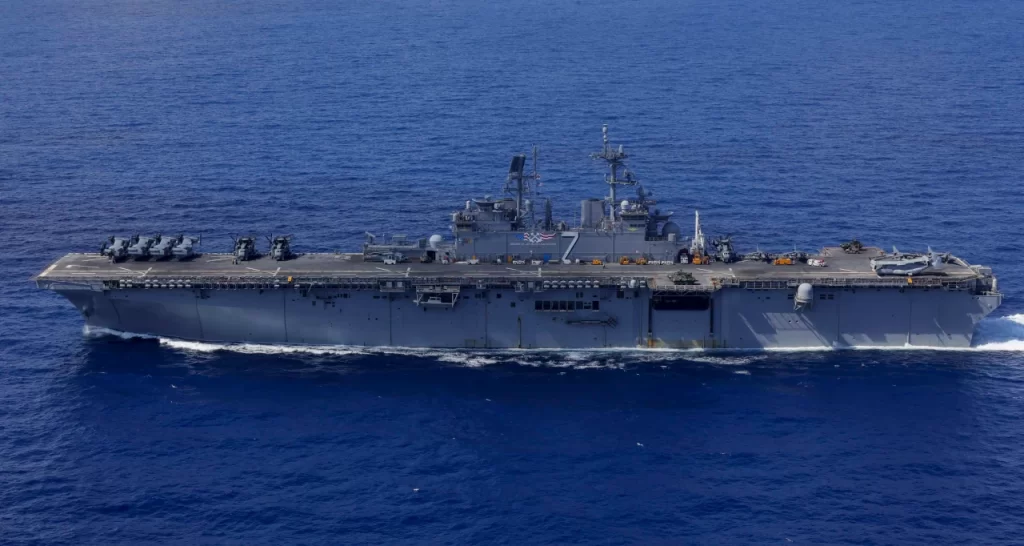The fourth Type 075 Universal Dock Landing Ship (UDK) of the People’s Liberation Army Navy (PLA Navy) of China, “Hubei” (湖北, Hubei), was officially commissioned on August 1, 2025, in conjunction with the 98th anniversary of the PLA’s establishment. The hull number 34 was assigned to this large amphibious assault ship, which was named after the Hubei Province of China. The ship was launched on December 14, 2023, at the Hudong-Zhonghua Shipbuilding Group shipyard in Shanghai. Subsequently, it participated in training exercises in the South China Sea alongside other Chinese Navy ships, including four Type 071 amphibious landing ships.
Type 075 UDKs are large ships in the helicopter carrier and dock landing ship categories, comparable in size to U.S. Wasp-class amphibious assault ships. The “Project 075” ships have a beam of approximately 36 meters, a length exceeding 230 meters, and a total displacement of approximately 35,000 to 40,000 tons. They are designed to carry approximately 900 to 1,200 marines and 28 to 30 helicopters of various types, and they are equipped with three Type 726 air-cushioned landing craft, each capable of transporting a light tank, the ZTQ-15. The ship can accommodate approximately 20 armored vehicles and up to 50 wheeled vehicles.
Before inducting “Hubei,” the PLA Navy had previously commissioned three other Type 075 UDKs: the lead ship “Hainan” (hull number 31), which was commissioned in 2021, and “Guangxi” (32) and “Anhui” (33), which were both commissioned in 2022. The operational range and mobility of marine forces have been considerably extended by these ships, which have also improved China’s helicopter carrier and amphibious capabilities.
The Type 076 “Sichuan,” a larger next-generation dock landing ship, is also being developed by China. The Type 076 “Sichuan” boasts a beam of approximately 50 meters, a length of approximately 260 meters, and a displacement exceeding 40,000 tons. The Type 076 will be equipped with electromagnetic catapults (EMALS) and arresting gear, which will allow it to operate carrier-based fighter aircraft. Consequently, its capabilities will be expanded beyond amphibious operations to include aviation support. In December 2024, the first Type 076 vessel was launched.
The gradual development of amphibious capabilities and the capacity to project influence in regional waters, such as the South China Sea, have been critical components of China’s navy’s growth. The Southern Fleet of the PLA Navy, which operates in strategically crucial and contested waters where China actively asserts its interests, is further fortified by the “Hubei.”
China is modernizing its fleet with the most advanced iteration of UDKs, thereby elevating its naval status and capabilities to levels comparable to those of the most advanced U.S. amphibious assault ships. While still trailing the largest American ships of the “Wasp” and “America” classes, China’s newest vessels, particularly the Type 076, are closing the gap in size and technical sophistication, reflecting Beijing’s ambition to enhance its maritime power on a global scale.

Comparison with Wasp-Class
Chinese Type 075 amphibious assault ships and their U.S. counterparts, the Wasp-class amphibious assault ships, are largely comparable in size and function; however, they differ in certain technological aspects and capabilities. The displacement of Type 075 ships is approximately 35,000–40,000 tons, which is comparable to the approximately 40,000-ton Wasp-class. Both classes are designed to deploy marines, helicopters, and landing craft for amphibious assault missions, and they serve as helicopter carriers and amphibious landing platforms.
Nevertheless, Wasp-class ships have been in service since the late 1980s and are equipped with advanced facilities, such as a built-in hospital with extensive medical capabilities. They are capable of transporting a full Marine Expeditionary Unit, approximately 1,894 personnel, and a substantial number of armored vehicles, including M1 Abrams tanks. The Wasp-class can operate Harrier II jump jets and, more recently, F-35B Lightning II stealth fighters, which provide a major air combat and strike capability in addition to rotary-wing operations.
In contrast, the Type 075 is currently incapable of deploying fixed-wing carrier-based fighters such as the F-35B, and its primary focus is on helicopter operations and amphibious assault, with the capacity to accommodate 28–30 helicopters. The Type 075 is equipped with three Type 726 air-cushioned landing craft, which facilitate the rapid deployment of vehicles and soldiers ashore. Its design prioritizes modern sensors and communications, but it employs conventional propulsion. In contrast, U.S. ships are equipped with more sophisticated integrated defense and countermeasure systems.
As a result, even though the Type 075 is getting closer to matching the size, troop capacity, and aviation features of U.S. amphibious assault ships, it still doesn’t completely match the wider ability to project air power that Wasp-class ships have for fixed-wing aircraft. The ongoing development of the larger Type 076 class in China, which includes electromagnetic launch systems, indicates a potential future initiative to achieve full carrier-like aviation capabilities, thereby further narrowing the technological and capability disparity.
In Conclusion,
The commissioning of Hubei’s commissioning represents a significant milestone in the modernization of China’s amphibious forces. It represents not only technical advancement but also improved operational capability for power projection and control in critical maritime regions that are essential to China’s national security and global aspirations.
